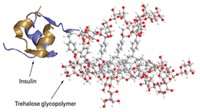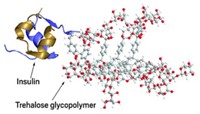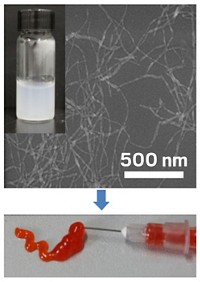Advertisement
Grab your lab coat. Let's get started
Welcome!
Welcome!
Create an account below to get 6 C&EN articles per month, receive newsletters and more - all free.
It seems this is your first time logging in online. Please enter the following information to continue.
As an ACS member you automatically get access to this site. All we need is few more details to create your reading experience.
Not you? Sign in with a different account.
Not you? Sign in with a different account.
ERROR 1
ERROR 1
ERROR 2
ERROR 2
ERROR 2
ERROR 2
ERROR 2
Password and Confirm password must match.
If you have an ACS member number, please enter it here so we can link this account to your membership. (optional)
ERROR 2
ACS values your privacy. By submitting your information, you are gaining access to C&EN and subscribing to our weekly newsletter. We use the information you provide to make your reading experience better, and we will never sell your data to third party members.
Materials
Artificial Clotting Agent Could Treat Internal Bleeding In Combat Zones
Nanomaterials: Heat-stable polymeric nanoparticles improve survival when injected in wounded rats
by Deirdre Lockwood
February 4, 2016

After a traumatic battle wound, a soldier can bleed to death in less than 10 minutes. Though injectable blood-clotting agents could help medics stop internal bleeding at the scene of an injury, most of the agents under development aren’t stable at the extreme temperatures in some combat zones. Now a group of researchers has designed nanoparticles that could address this need: They enhance clotting, improve survival in injured rats, and remain stable for a week at 50 °C (ACS Biomater. Sci. Eng. 2016, DOI: 10.1021/acsbiomaterials.5b00493).
Several years ago, Erin B. Lavik of the University of Maryland, Baltimore County, and her colleagues designed a nanoparticle with a poly(lactic-co-glycolic acid) (PLGA) core that stemmed bleeding in injured rats and was stable at room temperature (Sci. Transl. Med. 2009, DOI: 10.1126/scitranslmed.3000397). But when she talked with members of the U.S. military about applying the technology in locations such as Afghanistan, they warned her that temperatures there can reach 50 °C. Heated to that temperature, the nanoparticles “turned into a blob,” she says. “We had to rethink the chemistry of the material.”
So she and her colleagues transformed their original design into something more stable. They replaced the PLGA core in the original nanoparticles with polylactic acid (PLA), a crystalline polymer that can form complexes between stereoisomers, to make them less heat sensitive. In both designs, the cores were attached to polyethylene glycol arms bearing the clotting agent—a glycoprotein peptide—on the ends. Platelets have receptors for this peptide, arginine-glycine-aspartic acid, which is abundant in the body. When platelets are activated in the case of a traumatic injury, they grab onto these peptides to begin forming a clot. Lavik and her coworkers think the nanoparticles act like bridges between platelets to make clots form faster.
The team found that the new nanoparticles stimulated platelet aggregation in cell culture. Then they tested the nanoparticles by injecting them in the tail vein of rats with traumatic liver injury. Twice as many of these rats survived the hour-long test as compared with rats injected with control nanoparticles bearing a different peptide. After the researchers heated the nanoparticles to 50 °C for one week, they performed just as well as in earlier tests.
The team plans to continue to test the technology in different animal models to determine whether it could be applied clinically, Lavik says. If successful, it could be significantly less expensive than some drug alternatives.
Suzie H. Pun, a bioengineer at the University of Washington who has developed similar clotting agents, says she is excited about the new work because it addresses the need for trauma treatment formulations that are stable under extreme heat and humidity—important for military applications. The researchers have “convincingly demonstrated” its effectiveness in an animal model, she adds.





Join the conversation
Contact the reporter
Submit a Letter to the Editor for publication
Engage with us on Twitter